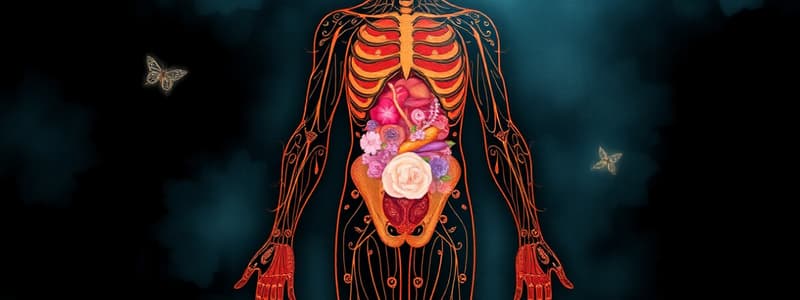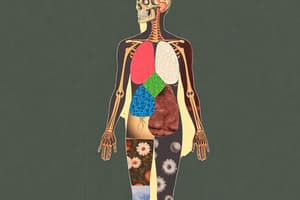Podcast
Questions and Answers
What are the two upper chambers of the heart called?
What are the two upper chambers of the heart called?
- Ventricles
- Arteries
- Veins
- Atria (correct)
What is the main function of arteries in the circulatory system?
What is the main function of arteries in the circulatory system?
- Regulate blood flow back to the heart
- Exchange nutrients with tissues
- Transport oxygenated blood away from the heart (correct)
- Carry blood towards the heart
Which component of the heart prevents blood from flowing backwards?
Which component of the heart prevents blood from flowing backwards?
- Valves (correct)
- Arteries
- Chambers
- Muscles
What is the sequence of blood flow when the heart beat begins?
What is the sequence of blood flow when the heart beat begins?
Which of the following blood vessels primarily carry deoxygenated blood?
Which of the following blood vessels primarily carry deoxygenated blood?
In multicellular organisms, what is the primary purpose of a transport system?
In multicellular organisms, what is the primary purpose of a transport system?
Which type of blood vessel is primarily responsible for exchanging substances with body cells?
Which type of blood vessel is primarily responsible for exchanging substances with body cells?
What role do veins play in the circulatory system?
What role do veins play in the circulatory system?
What is the primary purpose of the 11 organ systems in the human body?
What is the primary purpose of the 11 organ systems in the human body?
Which tissue type is primarily responsible for body movement?
Which tissue type is primarily responsible for body movement?
Which of the following is not a type of tissue found in the human body?
Which of the following is not a type of tissue found in the human body?
What are the three major parts of the circulatory system?
What are the three major parts of the circulatory system?
What is a primary function of connective tissue?
What is a primary function of connective tissue?
Which statement best describes epithelial tissue?
Which statement best describes epithelial tissue?
Which component of the circulatory system helps to carry hormones?
Which component of the circulatory system helps to carry hormones?
What role does the circulatory system play in waste management within the body?
What role does the circulatory system play in waste management within the body?
What is the main function of pulmonary circulation?
What is the main function of pulmonary circulation?
Which part of the heart separates the left atrium from the left ventricle?
Which part of the heart separates the left atrium from the left ventricle?
What characteristic distinguishes oxygen-rich blood from oxygen-poor blood?
What characteristic distinguishes oxygen-rich blood from oxygen-poor blood?
Which of the following statements is true regarding the heart's chambers?
Which of the following statements is true regarding the heart's chambers?
Which type of circulation supplies nourishment to all body tissues except the heart and lungs?
Which type of circulation supplies nourishment to all body tissues except the heart and lungs?
What role do heart valves play in the circulatory system?
What role do heart valves play in the circulatory system?
What does the systemic circulation primarily deal with?
What does the systemic circulation primarily deal with?
What is the primary function of the coronary circulation?
What is the primary function of the coronary circulation?
What is the primary function of arteries?
What is the primary function of arteries?
Why do veins contain valves?
Why do veins contain valves?
What is a significant characteristic of capillaries?
What is a significant characteristic of capillaries?
How do body muscles contribute to blood circulation in veins?
How do body muscles contribute to blood circulation in veins?
What type of blood do pulmonary veins carry?
What type of blood do pulmonary veins carry?
What role do red blood cells play in the blood?
What role do red blood cells play in the blood?
Why are artery walls thicker than those of veins?
Why are artery walls thicker than those of veins?
What does the plasma in blood transport?
What does the plasma in blood transport?
What is the primary function of red blood cells?
What is the primary function of red blood cells?
Which of the following correctly describes the composition of plasma?
Which of the following correctly describes the composition of plasma?
What is a characteristic of white blood cells?
What is a characteristic of white blood cells?
What is the lifespan of a red blood cell?
What is the lifespan of a red blood cell?
What are platelets primarily responsible for?
What are platelets primarily responsible for?
Which blood disorder is characterized by an abnormally low number of red blood cells?
Which blood disorder is characterized by an abnormally low number of red blood cells?
Which type of white blood cell is primarily involved in digesting micro-organisms?
Which type of white blood cell is primarily involved in digesting micro-organisms?
What is the approximate number of red blood cells in one drop of blood?
What is the approximate number of red blood cells in one drop of blood?
Flashcards
Heart Chambers
Heart Chambers
The heart has four chambers: two atria and two ventricles.
Atria
Atria
Two upper chambers of the heart that receive blood.
Ventricles
Ventricles
Two lower chambers of the heart that pump blood out.
Coronary Arteries
Coronary Arteries
Signup and view all the flashcards
Arteries
Arteries
Signup and view all the flashcards
Veins
Veins
Signup and view all the flashcards
Capillaries
Capillaries
Signup and view all the flashcards
Pulmonary Arteries
Pulmonary Arteries
Signup and view all the flashcards
Aorta
Aorta
Signup and view all the flashcards
Levels of Organization
Levels of Organization
Signup and view all the flashcards
Epithelial Tissue
Epithelial Tissue
Signup and view all the flashcards
Connective Tissue
Connective Tissue
Signup and view all the flashcards
Nervous Tissue
Nervous Tissue
Signup and view all the flashcards
Muscle Tissue
Muscle Tissue
Signup and view all the flashcards
Circulatory System Function
Circulatory System Function
Signup and view all the flashcards
Circulatory System Components
Circulatory System Components
Signup and view all the flashcards
Homeostasis
Homeostasis
Signup and view all the flashcards
Artery Function
Artery Function
Signup and view all the flashcards
Artery Structure
Artery Structure
Signup and view all the flashcards
Vein Function
Vein Function
Signup and view all the flashcards
Vein Structure
Vein Structure
Signup and view all the flashcards
Capillary Function
Capillary Function
Signup and view all the flashcards
Capillary Structure
Capillary Structure
Signup and view all the flashcards
Blood Components
Blood Components
Signup and view all the flashcards
Blood Function
Blood Function
Signup and view all the flashcards
Blood Composition
Blood Composition
Signup and view all the flashcards
Red Blood Cells (RBCs)
Red Blood Cells (RBCs)
Signup and view all the flashcards
Plasma
Plasma
Signup and view all the flashcards
White Blood Cells (WBCs)
White Blood Cells (WBCs)
Signup and view all the flashcards
Platelets
Platelets
Signup and view all the flashcards
Hemoglobin
Hemoglobin
Signup and view all the flashcards
Blood Clotting
Blood Clotting
Signup and view all the flashcards
Anaemia
Anaemia
Signup and view all the flashcards
Hemophilia
Hemophilia
Signup and view all the flashcards
Leukemia
Leukemia
Signup and view all the flashcards
Pulmonary Vein
Pulmonary Vein
Signup and view all the flashcards
Pulmonary Artery
Pulmonary Artery
Signup and view all the flashcards
Double Circulatory System
Double Circulatory System
Signup and view all the flashcards
Oxygen-poor blood
Oxygen-poor blood
Signup and view all the flashcards
Oxygen-rich blood
Oxygen-rich blood
Signup and view all the flashcards
Pulmonary Circulation
Pulmonary Circulation
Signup and view all the flashcards
Coronary Circulation
Coronary Circulation
Signup and view all the flashcards
Systemic Circulation
Systemic Circulation
Signup and view all the flashcards
Atria
Atria
Signup and view all the flashcards
Ventricles
Ventricles
Signup and view all the flashcards
Tricuspid Valve
Tricuspid Valve
Signup and view all the flashcards
Bicuspid (Mitral) Valve
Bicuspid (Mitral) Valve
Signup and view all the flashcards
Vein
Vein
Signup and view all the flashcards
Artery
Artery
Signup and view all the flashcards
Study Notes
Levels of Organization
- The human body is organized in several levels, from simple to complex
- Cells: The basic unit of life
- Tissues: Clusters of cells performing a similar function
- Organs: Made of tissues, performing a specific function
- Organ Systems: Groups of organs that work together for a specific purpose in the body
- Homeostasis is the purpose of the 11 organ systems in maintaining balance in the human body.
Types of Tissue
- Tissue is an aggregate of similar cells and cell products, forming a structural material with a specific function in multicellular organisms
- Four major types
- Epithelial
- Connective
- Nerve
- Muscle
Epithelial Tissue
- Also called epithelium
- Forms the outer layer of skin
- An interface tissue, covering body surfaces and lining body cavities (like the trachea and mouth)
Connective Tissue
- One of the most widespread tissues in the body
- Connects muscle to muscle, bone to muscle, and bone to bone
- Includes cartilage, adipose (fat), blood, and bone tissue
Nerve Tissue
- Allows feeling and sensing, and responding to stimuli
- Neurons are a type of nerve tissue
Muscle Tissue
- Highly cellular
- Responsible for most body movements
- Includes skeletal and cardiac muscle tissues
Circulatory System
- A transportation system for oxygen and nutrients to body cells, and removal of waste materials.
- Also transports hormones to regulate bodily functions, and antibodies to fight infections
- Divided into three parts:
- Heart
- Blood
- Blood Vessels
The Heart
- Size of a fist
- Thick muscular walls
- Divided into two pumps
- Each pump has two chambers
- Atria (upper chambers) that receive blood from veins
- Ventricles (lower chambers) that pump blood out into arteries
- Each pump has two chambers
- Valves (bicuspid and tricuspid, pulmonary and aortic) prevent blood from flowing backwards
Functions of The Circulatory System / Types of Circulation
- Pulmonary Circulation: Blood moves from the heart to the lungs and returns to the heart
- Coronary Circulation: Blood flows through cardiac muscle cells of the heart
- Systemic Circulation: Nourishes tissues throughout the body, excluding the heart and lungs.
Blood
- Pumped by the heart
- Travels throughout the body via thousands of miles of blood vessels
- Carries nutrients, water, oxygen and waste products to and from cells
- Composed of liquids, solids, and small amounts of oxygen and carbon dioxide
- Major components
- Red blood cells: carry oxygen from lungs to body
- White blood cells: protect against disease
- Platelets: help blood clot
- Plasma: liquid part of blood; containing water, gases, nutrients, proteins, waste products, etc.
Blood Related Disorders
- Anemia: abnormally low red blood cell count
- Hemophilia: a bleeding disorder due to a lack of clotting factors
- Leukemia: cancer of the blood cells
Blood Vessels
- Hollow tubes within which blood flows
- Three types
- Arteries: carry blood away from the heart (except for pulmonary arteries)
- Thick walls with muscle and elastic fibers to withstand pressure and push blood along.
- Veins: carry blood to the heart
- Thinner walls, with valves that prevent backflow
- Capillaries: link arteries and veins, allow exchange of gases and nutrients between blood and body cells
- Very thin walls (only one cell thick) for efficient diffusion
- Arteries: carry blood away from the heart (except for pulmonary arteries)
Studying That Suits You
Use AI to generate personalized quizzes and flashcards to suit your learning preferences.




